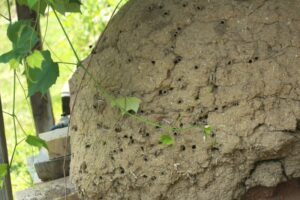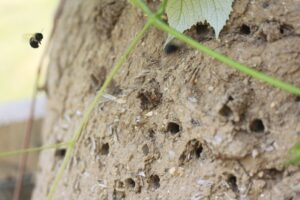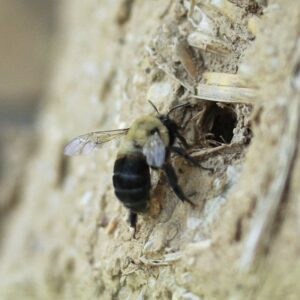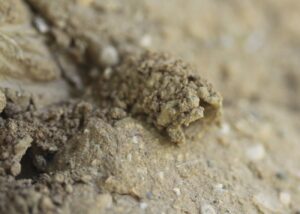Note: All links leave to external sites.
Greetings, BugFans,

In late spring, BugFan Sara sent some “Who-is-this-and-what-is-it-doing??” pictures—small “bumble bees” were excavating the outer surface of a clay bread oven in her back yard. (The BugLady gave Sara bonus points for having a clay bread oven in her back yard.) While she was mulling her answer, the BugLady found a reference to an Anthophora bee that is sometimes referred to as the Chimney or Turret bee. That looked promising, and her hunch was confirmed by BugFan PJ. Thanks, folks.

Family Apidae is a big umbrella in the bee world that includes Bumble, Cuckoo, Carpenter, Digger, and Honey bees – 1,000 species of them in North America and 5,000 species elsewhere. The star of today’s show is in the tribe Anthophorini, the Digger bees (68 species in our area and 766 worldwide). What they all have in common is a bumble-bee-ish appearance and the habit of most species of making nest tunnels in the soil.
Chimney bees (Anthophora abrupta) are solitary bees that can be found in woodlands and grasslands from Texas to the western Great Lakes to New England (solitary bees don’t have a central hive, a queen, or workers, and each female cares for her own brood). They’re chunky, medium-sized bees (0.50” to 0.60” long) that can be distinguished from bumble bees by their color pattern – dark heads, pale, golden thoraxes, and dark abdomens, and by their very, hairy legs. Males’ faces are light yellow with hairs around the edges, earning them another common name – the Mustached mud bee. For some great macro pictures, see https://www.fs.usda.gov/wildflowers/pollinators/pollinator-of-the-month/anthophora-abrupta.shtml and https://www.marylandbiodiversity.com/view/3137.
In 1929, entomologist Phil Rau published a paper about Chimney bees in the journal Psyche. The BugLady is interspersing her information with excerpts from Rau’s paper, written back in the days when scientific writing allowed a more lyrical tone.
“They are neither timid nor aggressive, but they certainly are self-reliant…how conspicuous they are as they noisily swing their ponderous bodies to and fro on the wing, arrive home and scramble into their burrows or come tumbling out headlong and dash off into the sunny fields, with all the exuberance of boys just out of school. They have none of the shy, stealthy ways of maneuvering, whereby some of the smaller and daintier varieties of bees and wasps hold their own in a competitive world.”
Chimney bees are generalist foragers that pollinate a wide array of wildflowers, and they’re also important pollinators of agricultural crops like cranberries, asparagus, tomatoes, blackberries, raspberries, and persimmons. Their docility (if you handle one roughly, it’s more likely to bite than sting), home-body ways, and gregarious nesting make them interesting to researchers looking for potential large-scale pollinators. Their long tongues allow them to reach the nectar in clover flowers.
Rau recalled watching female Chimney bees licking rust on old fence wire. A colleague speculated that while carnivorous insects glean minerals from the blood of their prey, the nectar-feeding Chimney bees may get minerals from rust.
Chimney bees are on the wing from late spring through late summer. Males emerge almost a week before females, and they attract females by deploying pheromones that are carried in their moustaches! Mating occurs on flowers (she mates once, but he may mate several times). After they mate, the female looks for a spot to excavate a tunnel, often in a clay bank above a stream, usually in the same nest area she emerged from.

Some solitary bees and wasps won’t tolerate the nearby nests of their sisters, but chimney bees prefer company. As Rau wrote, “Since they work in colonies, or more correctly remain to build on the site where they were born, the result is a very conspicuous village, sometimes a very crowded and busy town of these masonry turrets … At a busy season when many of these huge bees are bustling about with very audible hum and zip, the entire village with its many wonderful towers and industrious citizens form a spectacle which is in itself quite capable of overawing any but the most unemotional individual.”
She employs a pretty unique construction method – she brings water or mud to her site and uses it to soften the clay so she can dig. Each mouthful of dampened clay that she removes goes into building a chimney. Rau describes it: “With a portion of the water they would wet the hard, yellow clay, remove a mouthful of it, back out and apply it to the last ring in the chimney. The bees would carry the mud under the thorax with the front pair of legs, while the two hind pairs furnished locomotion; as the bee backed out of the nest to the opening, the ball of mud was passed to the hind legs, and she now held her footing with the front legs while with hind legs she slapped the mud onto the last layer and with many active thumps with the tip of the abdomen, punched and beat it into shape. ‘Punched’ is really the right word correctly to describe the gesture.”

Chimneys may be very short or up to 3” long, and they are oriented randomly. No one knows exactly why she makes the chimney (other than that it’s a convenient way to dispose of the diggings) – researchers have guessed that it protects the tunnel from rain and blowing debris, that it helps with thermoregulation of the nest, that there is social significance for the community, and/or that (as Rau suspected) it helps her find her tunnel among all the others.
Two factors may limit the building of chimneys – drought and a lack of clay in the nesting area. Rau wrote that “A. abrupta made nests either with or without turrets, and the turret-making activities were directly correlated with water conditions. They required water in abundance, and when it was plentiful, so too were the turrets; in droughty years they struggled on with few and small or no turrets, and their nesting activities were much reduced.”
She creates up to seven cells along the length of the tunnel (which is about 4” long), and here’s the magic part. The walls of the tunnel and of each of the egg cells are lined with a waxy substance she makes in a gland called a Dufour’s gland. The liquid made by the gland starts out clear, but it dries to a solid, waxy sheet that keeps moisture out of the tunnel and the cells. She carries pollen and nectar into the cell and mixes them with liquid from the Dufour’s gland, injects an egg into the mix (which one researcher describes as a “soupy mass”) and seals the cell with clay. The tunnel is covered with a clay plug when all the egg cells are provisioned. A large, communal nest may contain 5,000 cells.
Because the females don’t cap their tunnels when they are out looking for water, nectar and pollen, other females may try to take them over. Writes Rau “Not infrequently an animated fight was to be seen between two females, one evidently trying to usurp the burrow that had been made by another, and often dead bees were found at the foot of the bank.”
Frequently, however, the fights appeared quite alarming without proving fatal. One pollen-laden mother was seen backing out of her hole with the front leg of an intruder in her mandibles. The visitor showed no fight, but resisted with all her might; at the foot of the hole, every little gain that the rightful owner made was offset by the intruder pulling her back. At last the intruder lost her hold, and as they went tumbling to the ground they engaged in a pugnacious embrace.
After laying in the “soup” for five days, the egg hatches, and the larva feeds on the provisions and the cell lining. They overwinter as pre-pupae, finish their metamorphosis in spring, and emerge from the tunnel.
And if all that weren’t enough, male Chimney bees climb up grass stems in the evening, grip them with their jaws, and sleep suspended by their mandibles.
Ain’t Nature Grand!!
The BugLady